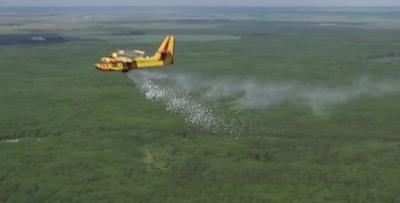Fri, Jan 24, 2020
HyDrop System Lifts The Long Standing Restriction On Nighttime Aerial Firefighting
Elbit Systems completed a successful field demonstration of its patented Hydrop system, an innovative solution enabling high-altitude high-precision aerial firefighting. The field demonstration took place recently as part of an exercise led by the Israel Fire and Rescue Authority. During the exercise two Air Tractor aircraft from the Israeli Fire Fighting Squadron were directed to extinguish a burning field, from as high as 500 ft., more than four times higher than the average altitude of a standard aerial firefighting sortie. Using the HyDrop system each aircraft launched 1.6-tons of 140-gram liquid pellets in a computed ballistic trajectory, achieving a precise hit with saturation of 1-2 liter per 1 square meter (approx 1-2 quarts per three square feet).

Since 1953, aerial firefighting has been carried out using liquid cascade drop methods that require sorties to be conducted at an altitude of a 100-120 ft. in order to reduce liquid loss caused by the aerosol effect. Such low-altitude flights are restricted to daytime due to safety concerns and Civil Aviation regulations. The experience from around the globe clearly shows that restricting aerial firefighting to daytime severely degrades its operational contribution. Addressing this needs gap, Elbit Systems developed the Hydrop system that enables a high-precision computed launch of biodegradable liquid pellets from 500-2,000 ft., altitudes that are safe and certified for night-flight by Civil Aviation.
With Helicopter, Fixed-wing and Heavy Lifter configurations, Hydrop integrates fighter aircraft avionics including a ballistic computer, command and control (C2) system and advanced display systems, together with liquid pellets stored in a specially designed airborne dispenser. The C2 unit navigates the aircraft to the drop point while the ballistic computer produces an accurate launch trajectory, taking into account aircraft velocity, altitude, GPS location, wind conditions and the weight and shape of the liquid pellets. In addition to lifting the restriction on nighttime aerial firefighting, this high-altitude system improves pilots safety and increases the effectiveness of aerial firefighting, during day and night, by eliminating the liquid loss caused by the aerosol effect.
The Hydrop system includes a pellets manufacturing machine (static or mobile). Housed in a standard 20'-container, the manufacturing machine can produce up to 10 tons of pellets per hour. The biodegradable pellets which can be filled with either water, foam or fire retardant, have been proved to have no harmful residues and their dropping has also been tested and found to be safe to crews on the ground.
(Source: Elbit Systems news release. Image from company YouTube video)
More News
Terminal Radar Service Area Airspace surrounding designated airports wherein ATC provides radar vectoring, sequencing, and separation on a full-time basis for all IFR and participa>[...]
Very High Frequency (VHF) The frequency band between 30 and 300 MHz. Portions of this band, 108 to 118 MHz, are used for certain NAVAIDs; 118 to 136 MHz are used for civil air/grou>[...]
“From approximately November 2021 through January 2022, Britton-Harr, acting on behalf of AeroVanti, entered into lease-purchase agreements for five Piaggio-manufactured airc>[...]
Also: Virtual FLRAA Prototype, IFR-Capable Autonomous A/C, NS-32 Crew, Golden Dome Missile Defense Bombardier announced that the first production Global 8000 successfully completed>[...]
Aero Linx: The 1-26 Association (Schweizer) The Association’s goal is to foster the helpfulness, the camaraderie, and the opportunity for head-to-head competition that is fou>[...]
 ANN's Daily Aero-Term (05.29.25): Terminal Radar Service Area
ANN's Daily Aero-Term (05.29.25): Terminal Radar Service Area ANN's Daily Aero-Term (05.30.25): Very High Frequency (VHF)
ANN's Daily Aero-Term (05.30.25): Very High Frequency (VHF) Aero-News: Quote of the Day (05.30.25)
Aero-News: Quote of the Day (05.30.25) Airborne 05.23.25: Global 8000, Qatar B747 Accepted, Aviation Merit Badge
Airborne 05.23.25: Global 8000, Qatar B747 Accepted, Aviation Merit Badge ANN's Daily Aero-Linx (05.30.25)
ANN's Daily Aero-Linx (05.30.25)



